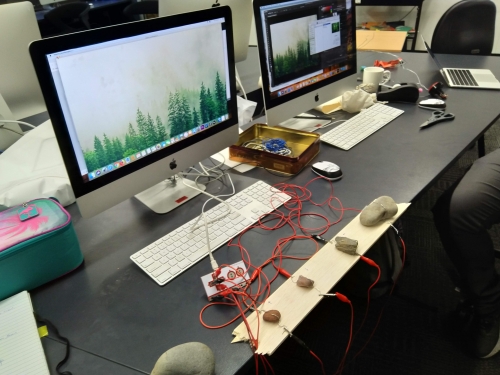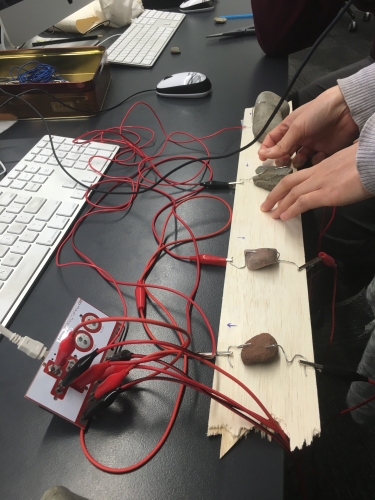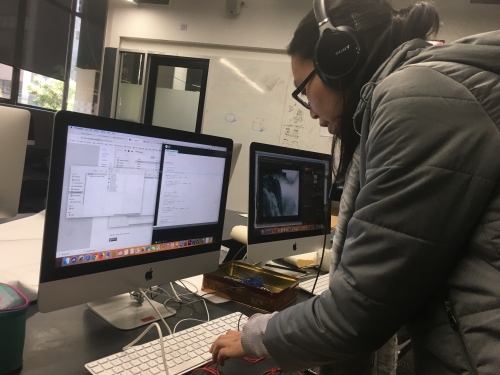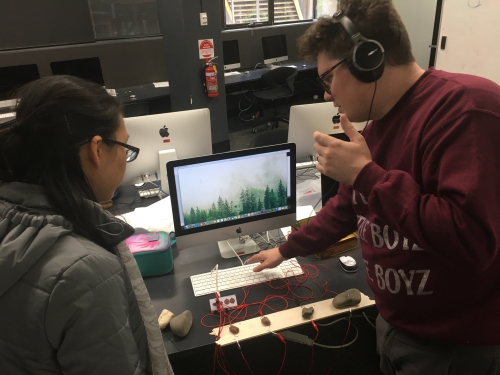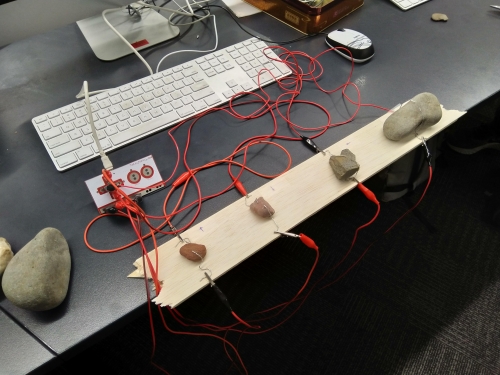***This week’s response was made in collaboration with Emmett Redding & Helen Kwok***
Theme
Play & Materiality - to consider how the translation of the material and the immaterial can be used to create playfully.
Method
We will use physical objects and the Makey-Makey kit to create an interactive keyboard that plays atmospheric soundtracks.
Context
OutsideIn Capsule - Mengyang Wang - https://cycling74.com/projects/outsidein-capsule
Wang’s work was the key influence for this week’s response, creating an interactive sound installation based on touch contained within a dark box. By isolating themselves in the space, the user’s uncoordinated experience engages with novel aspect of playful discovery and exploration to create a sensory experience. We hope to recreate a feeling of discovery and exploration in our response.
A Soft Murmur - https://asoftmurmur.com/
A website that allows the user to create atmospheric background noise using audio loops with adjustable volumes. The digital interface encourages users to tinker with the volume settings to create their own ideal background noise. We hope to use physical objects on a keyboard interface to help project an immaterial soundscape to incorporate this encouragement for the user to play with the settings and discover a soundscape they enjoy.
A Study in Play, Pleasure and Interaction Design - Brigid Costello & Ernest Edmonds
Through interaction with the physical objects on the keyboard interface, the user will be able to create their own auditory experience and engage with sensory elements of sight, sound and touch. Key pleasure categories we seek to explore through this installation include; sensation, feeling the physicals objects to create audio outputs; exploration, learning what ambient sounds each of the different objects produce; discovery, finding out what the combination of the atmospheric soundtracks will create.
Response
Our initial idea was to use material objects on the keyboard interface to project into the immaterial world they represent, creating soundscapes that represent each object, e.g. a seashell producing a beach soundscape. Due to the constraints of class time and lack of conductive materials in the studio, we decided to create our prototype using rocks and wire components which could later be substituted with physical models made from conductive materials. That said, the use of rocks as interface objects still evoked the notion of exploration.
Helen was then able to code the prototype program so that when the user completed the circuit by touching the two wire components on each individual rock, a soundscape (sourced by Emmett) would play while an image of a location (sourced by me) was revealed. When a second rock was touched, a different soundscape and location were activated and the first would deactivate.
After Evan playtested the installation, we noticed him trying to touch multiple rocks at once. Our second iteration allowed for the soundscapes to overlay, however as we ran out of alligator clips we were unable to add a reset button which would deactivate all current soundscapes and images. This meant that all the individual soundscapes combined created a rainforest soundscape.
Roles:
Coding - Helen
Sound - Emmett
Visuals & Wiring - Ben
Reflection
Due to the small number of alligator clips available, the level of output for our response was limited. We would have liked to include more interactive objects on the board, including shorted sounds and a reset button. As a result, the sense of discovery in the installation is rather short-lived, and users learn the soundscapes immediately upon interaction, preventing full immersion in the play experience.
Additionally, having objects that visually related to the soundscape output definitely would have helped create more unison between the touch and audio experience. While we initially considered having objects that belonged to said environments, e.g. a sea shell or plant leaves, we were unable to bridge the gap between material and immaterial due to lack of conductivity in objects around the studio.
An aspect of the response that could also be expanded upon would be to try blindfolding the user and having them interact with the installation without seeing what objects are available. This would lean more heavily in the play-realm of exploration and discovery, causing the user to rely on their sense of touch and be surprised by what objects they find.
Lastly, the ability to overlay the sounds in our second iteration contributed a lot to the feeling of ambience, however, we weren’t able to allow the user to adjust any audio settings themselves. For future iterations, we could consider ways to incorporate these settings into the keyboard interface, whether it be rotating or tilting objects. This could be playful where a user may only notice this feature after accidentally rotating an object on the interface, causing them to investigate the same settings on the other objects.
About This Work
By Ben Mansur
Email Ben Mansur
Published On: 30/09/2019
academic:
mediums:
interactive, physical, programmatic, sound

